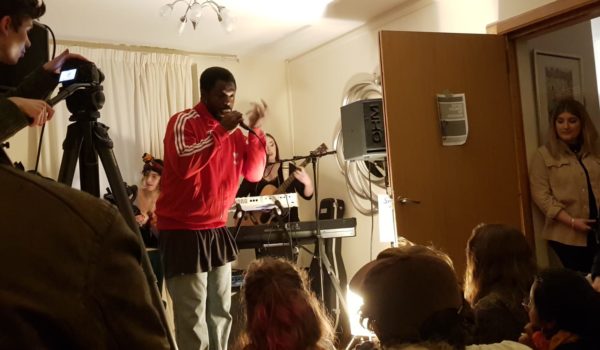Morgan continues blighting The Record with his ramblings, mainly as an excuse to avoid doing the dishes.
Bioshock Infinite was released in 2013 to the collective confusion of many fans. Picture it: you’ve spent the first two games sitting in the bottom of the Mariana Trench drugging yourself six ways to Sunday, but in these new gameplay trailers, there isn’t a single drop of water or filthy syringe in sight. There’s little relation with the original Bioshock; it’s less wearing the Bioshock logo’s skin than it is upholstering the furniture in Leatherface’s man-cave. The setting is different, the enemies are different, the themes are different – a welcome change, yes, considering how Bioshock 2was about as well-received as a three-month old pomegranate under direct sunlight, but if it didn’t bear the series name, chances are you’d be hard-pressed to realise they’d be in any way linked.
But if Bioshock Infinite has next to nothing that made the original Bioshock such a hit, then why do I like it more? First off, the story’s much simpler to follow; you are surprisingly un-mute protagonist Booker DeWitt, private detective and professional grumpy cynic cliché (order now and get free tragic backstory with every purchase), who is summoned to a flying city named Colombia on a mission that we’re sure is in no way connected to your past life. It’s bright, it’s colourful, it’s in the sky instead of the sea, everyone’s blatantly racist as per the 1920s American way… it’s the exact opposite of what the first Bioshock looked like, further strengthening the divide.
Say what you want about the change of aesthetic, but even the most hardened sceptic (i.e. me) would have to admit that the game wastes little time in making your new enemies nice and hateable. After all, there’s a reason Nazis are the classic lead fodder of the modern video game industry: why give your hero a personal reason to hate them when just making them a bunch of xenophobic fundamentalist lunatics will do?
Unlike with the drug-addled wrecks of Rapture, who were often too off-their-face to notice you until you were performing extensive brain surgery on them with a two-tonne wrench, the first group of walking target boards you face are the city police. I suppose that’s one of the advantages of going the “borderline Nazi” route; if you were just running around breaking the necks of regular cops, who likely have a life and family, you might stop and realise how disturbing the scenario is. But nope, if they hate black people then you’ll never once feel sympathy for them. Even when you’ve drank so many “vigors” (this game’s name for plasmids) that you fart lightning, you’ll still smile gayly as you zip over on an overhead rail, kick the door in and set seventeen of them alight halfway through their first racial slur.
Biosho – you know what, I’m sick and tired of saying that name by this point, so from now on we’re calling it Extremist-Murdering Simulator. The big baddy of Extremist-Murdering Simulator Infinite is nothing much to write home about, but by this point that’s practically a given. I’ve never considered the Extremist Murder Simulator franchise to have particularly interesting main villains: Andrew Ryan in the first game was a pompous ultra-capitalist who had a stick lodged so far up his backside that one end was poking out of his mouth. Then the villain of Extremist-Murdering Simulator 2, Nameless-Woman-Science-Lady, had the genius masterplan of boring me into a coma by mercilessly reading the shipping forecast at me or something.
Zachary Comstock, this game’s bastard du jour, is a slight step above. As a self-appointed prophet and leader of Colombia, he’s the one responsible for the continued anti-minority stance all the inhabitants of the city have. He’s a bit on-the-nose with his ramblings of American exceptionalism and the wrath of God, but I think it’s quite nice to see the worse parts of American history on display for all to see, especially given today’s political climate. Never mind the fact that I’m a red-blooded Englishman whose ancestors burned their capital city to the ground in 1814, it’s a good reminder of acknowledging the past but not embracing it as a good time gone. Especially for people like that alt-right group who used the design of an enemy propaganda poster out of this very game to promote their pathetic little party. True story, look it up.
Sorry, that got all deep there, didn’t it? Just pretend I made a farting noise or something after the last sentence, that should help.
It’s often said that life is made up of choices and one area where Extremist Murder Simulator Infinite definitely made the right choice was dealing with its female lead. She’s a young woman who’s dragged into the mix when, in a shocking twist, the mission that we’re sure in no way connects to your old life suddenly and mysteriously connects to your old life. Even though I’m a lowly specimen of humanity who gets his kicks by ringing up local orphanages, demanding they put me on speaker and then shouting loudly down the line that Santa doesn’t exist, I’m going to really try and not spoil anything here. To put it simply, the interactions between the two feel genuine, she’s more than a squealing target that you have to act as a human shield for and the relationship develops between the two of you before being tied up quite nicely with an ending that shows just how much one really needs the other.
There’s a subplot that involves a group of rebels fighting against the city authorities, who are at first portrayed as a ragtag group of kind-hearted folks wanting to make the city a better place, a la the Star Wars saga. But you quickly learn that they’re the same, if not just as bad, also indulging in the odd killing spree against whoever they perceive to be enemies of the cause. Both groups get equal amounts of narc on whenever Booker DeWitt so much as breathes incorrectly in their direction, and both are happy to introduce you to the business end of their ten-barrel chain gun the microsecond you step into the room.
You personally are never given the choice of picking a side, which I’d say is for the best – all the moral choices in this game hold just as much weight as those in the first two games, namely somewhere in the region between “bugger” and “all”. This attempt to introduce a grey area into what was initially established as a black and white dichotomy is a bit incongruous, what with Dewitt acting as that area already. After all, whilst your naïve companion questions all the injustices you see and the bloodshed you’re responsible for, you’re mean, rude and feel nothing but complete indifference to the social issues around yourself.
Overall, Extremist Murder Simulator Infinite – blimey, even that’s getting boring to say now – is the peak of the franchise. Every issue I had with the first two games are much improved: the environments and different enemy types encourage you to use a wider variety of vigors, audio logs for piecing the story together can be found in areas other than the middle of fifty-decibel firefights and the ending is both a little depressing and at the same time satisfying. Granted, a scenario where you’re put against a wall and shouted at to turn around by a man with a gun would be a more fulfilling ending than those of the first two games, but at least this time around you can tell they put more than just ten minutes of effort into it.








Comments